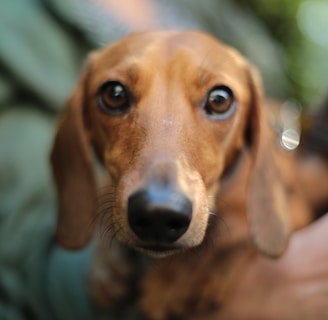Why Do Dogs Have Whiskers?
By respecting and caring for a dog's whiskers, we can ensure that they continue to thrive and navigate their world with confidence and grace.
DOG HEALTHDOG TRAININGDOG LIFESTYLE
1/2/20243 min read


Dogs, our loyal companions, possess a multitude of fascinating features that often go unnoticed. Among these is the humble whisker, a seemingly simple aspect of their anatomy that holds profound significance. In this article, we will delve into the mysteries surrounding why dogs have whiskers and explore the various functions and importance of this unique feature.
The Purpose of Whiskers:
Whiskers, also known as vibrissae, are long, thick hairs that protrude from specific areas of a dog's face, primarily around the muzzle, above the eyes, and on the cheeks. While they may appear inconspicuous, whiskers serve several crucial functions in a dog's life.
Sensory Perception:
One of the primary purposes of whiskers is to provide dogs with enhanced sensory perception. These specialized hairs are deeply rooted in the nerve-rich follicles and are highly sensitive to even the slightest touch or movement in the surrounding environment. This heightened sensitivity allows dogs to navigate their surroundings with precision, especially in low-light conditions or when their vision is compromised.
Whiskers act as a natural sensory system, providing dogs with valuable information about their immediate surroundings. They can detect changes in air currents, temperature, and even the presence of nearby objects or obstacles. This sensory perception is particularly useful for dogs that engage in activities such as hunting, tracking, or navigating through narrow spaces.
Communication and Social Interaction:
In addition to their sensory functions, whiskers also play a crucial role in communication and social interaction among dogs. When a dog is interacting with another canine, their whiskers can provide subtle cues and convey important information.
For example, during play or aggressive encounters, a dog's whiskers may become more prominent or move in specific ways, indicating their emotional state and intentions to the other dog. This non-verbal communication helps dogs establish boundaries, express their emotions, and maintain social harmony within their pack or social group.
Protection and Navigation:
Whiskers also serve as a form of protection and aid in navigation for dogs. The length and positioning of a dog's whiskers are specifically adapted to their body size and the environment in which they live.
When a dog is exploring unfamiliar terrain or navigating through tight spaces, their whiskers help them gauge the width of openings and potential obstacles. By brushing against objects or walls, the whiskers provide valuable feedback to the dog, allowing them to adjust their movements accordingly and avoid potential harm or entrapment.
In addition, whiskers act as a protective mechanism by alerting dogs to potential dangers. If a dog's whiskers come into contact with a sharp object or a potential threat, they will instinctively react, pulling their head back or changing their course to avoid harm.
Whiskers in Different Dog Breeds:
While all dogs have whiskers, the characteristics of these facial hairs can vary among different breeds. Some breeds have longer and more prominent whiskers, while others may have shorter and less noticeable ones.
For example, breeds such as the Schnauzer and the Wirehaired Pointing Griffon are known for their distinct facial whiskers, which are often groomed and shaped to enhance their appearance. On the other hand, breeds like the Boxer or the Greyhound may have shorter whiskers that are less prominent but still serve the same essential functions.
It's important to note that the length and appearance of a dog's whiskers are primarily determined by their genetics and breed characteristics. Grooming or trimming a dog's whiskers can disrupt their natural sensory abilities and should be avoided.
Caring for a Dog's Whiskers:
Given the significance of whiskers in a dog's life, it is essential to provide proper care and attention to this unique feature.
Avoid Trimming or Plucking:
As mentioned earlier, trimming or plucking a dog's whiskers can have adverse effects on their sensory perception and overall well-being. It is crucial to resist the temptation to groom or alter a dog's whiskers for cosmetic purposes.
If a dog's whiskers become damaged or broken, they will naturally shed and regrow over time. It is best to let this process occur naturally without any interference.
Maintain a Safe Environment:
Creating a safe environment for your dog is essential to protect their whiskers from potential harm. Ensure that there are no sharp objects or hazards in their surroundings that could accidentally damage their sensitive whiskers.
Additionally, be mindful of the grooming tools you use around your dog's face. Avoid using sharp or abrasive tools that could accidentally injure or pull on their whiskers.
Regular Veterinary Check-ups:
During routine veterinary check-ups, it is advisable to have your dog's whiskers examined as part of their overall health assessment. A veterinarian can assess the condition of the whiskers and provide guidance on any specific care or concerns.
Conclusion:
Whiskers, the seemingly simple yet remarkable feature of a dog's anatomy, serve a multitude of important functions. From sensory perception and communication to protection and navigation, these specialized hairs play an integral role in a dog's life.
Understanding the significance of whiskers allows us to appreciate the intricate design of our canine companions and provides insights into their unique abilities and behaviors. By respecting and caring for a dog's whiskers, we can ensure that they continue to thrive and navigate their world with confidence and grace.
Subscribe to our newsletter
HEALTHY DOGGOS 2023 COPYRIGHT
